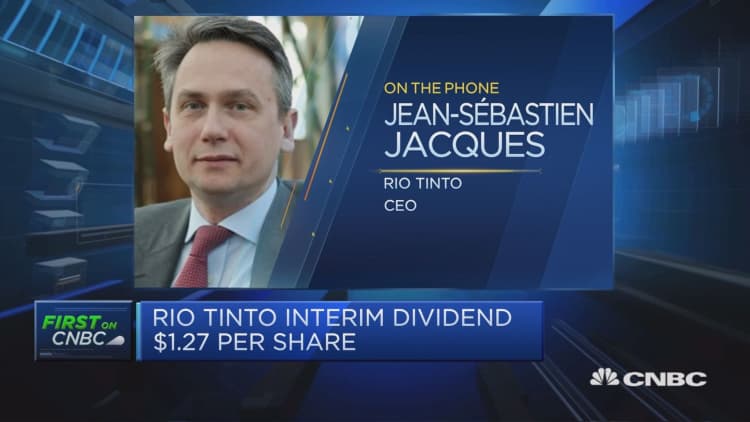
Rio Tinto reported a rise in first-half profit for 2018 of 12 percent year-on-year, and announced an additional share buyback and dividend hike.
Underlying profit for the first six months of the year came in at $4.42 billion, up from $3.94 billion in the same period last year.
Despite the profit rise, figures missed estimates, sending shares lower during Wednesday morning trading. Earnings were initially forecast at $4.53 billion by an independent survey of analysts. Company shares were down 3.76 percent on the London Stock Exchange at 9:45 a.m. local time (4:45 a.m. ET).
The mining giant announced plans to buy back an additional $ 1 billion in shares, aiming for completion by the end of February 2019. Rio Tinto also reported an interim dividend of $1.27 per share, up 15 percent on the year.
The total interim dividend figure was $2.2 billion, the highest in the company's 136-year history. Speaking to CNBC's "Squawk Box Europe", Rio Tinto chief executive Jean-Sebastien Jacques was positive about the company's returns. "We have delivered what we've committed, which is to deliver cash returns in the short, medium and long term," he said.
The higher dividends come amid stronger commodity prices, which have rebounded following China's slowdown in 2015 and 2016. Mid to high-grade iron ore prices have been supported by strengthened Chinese steel futures this quarter, although investors are concerned over the potential adverse impact of a trade war.
Whether negative or positive, "China's growth pathway could impact demand for the group's products outside of expectations," the company said in a statement.
Copper, whose production for the company was 26 percent higher year-on-year, saw prices trend downward toward the end of the second quarter, but during the quarter hit four-year highs.
'No impact' from trade war
Asked if he foresaw a cyclical downturn triggered by central bank tightening or a trade war, Jacques was unconcerned. He pointed to the two key drivers of the mining industry: cited gross domestic product (GDP) growth and world trade.
"As far as we see it today, the outlook for GDP growth is pretty strong — in the U.S., in Canada, in China for example — so we don't have too much of a concern on this one," he said.
"On trade, it's important to split facts from noise," the CEO continued. "Today if I look at it from a Rio Tinto standpoint, I do not have any issues whatsoever. So the demand for product, either copper or bauxite or aluminum or iron ore, is very strong. So we haven't seen any impact so far over the trade."
The Anglo-Australian multinational said it shipped 88.5 million tons of iron ore in the second quarter of the year, a jump of 14 percent compared to the second quarter of 2017, due to improved productivity and fewer adverse weather conditions. It expects the year's shipments to be at the upper end of the current guidance range of 330 to 340 million tons.
Rio Tinto also delivered $0.3 billion in additional free cash flow in the first half from its mine-to-mine productivity program.


